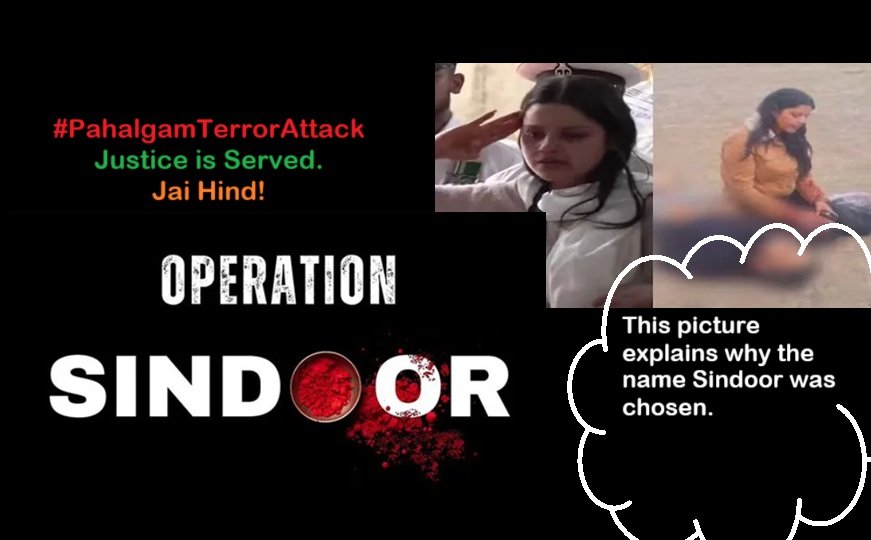
In a deeply symbolic and emotionally charged response to one of the most gruesome terror attacks in recent Indian memory, the Indian government has named its counterstrike against Pakistan-based terror outfits Operation Sindoor. The decision reflects not only strategic intent but also a profound recognition of the personal losses suffered by families affected by the Pahalgam massacre — a massacre that crossed every conceivable red line of humanity.
Read This: India Launches ‘Operation Sindoor’; Precision Strikes Hit Nine Terror Camps in Pakistan and PoJK
The Pahalgam Massacre: A Tragedy Beyond Numbers
The terrorist attack in Pahalgam was more than an act of violence — it was an atrocity deliberately designed to inflict deep psychological and communal wounds. Armed terrorists stormed a group of Indian tourists, demanded to know their religion, and executed 26 unarmed civilians, including decorated personnel like Indian Navy officer Lieutenant Vinay Narwal, in front of their wives and children.
Among the most haunting images from the attack was that of Himanshi Narwal, still wearing her wedding chooda, sitting beside her husband’s lifeless body. Their marriage was just days old. In another heartbreaking scene, Pallavi Rao, wife of Manjunath Rao, who had shared joyful moments just the previous day on a shikara ride, was seen crying for help after her husband was gunned down.
The attack left 25 women widowed, many of them newly married. This was not only a national tragedy but an intimate assault on the sanctity of marriage, womanhood, and life itself.
Why ‘Sindoor’? A Name Laden with Meaning
In Indian culture, sindoor (vermilion) holds deep significance. It is not just a cosmetic item; it is a sacred symbol of marital status and commitment. Traditionally applied along the parting of a woman’s hair, sindoor symbolizes love, prosperity, and the long life of her husband.
By naming the operation ‘Operation Sindoor’, India has made a statement far more powerful than any political speech. It is a direct tribute to the women whose sindoor was cruelly wiped away by the barbarity of terrorists.
An image released by the Indian Army, showing the operation’s name in bold letters, captured this sentiment perfectly. One of the “O”s in “Sindoor” was illustrated as a bowl of vermilion, with some of it spilled — a visual metaphor for the tears, trauma, and spilled blood that the operation seeks to avenge.
A Decision at the Highest Level
According to a report by Press Trust of India (PTI), it was Prime Minister Narendra Modi himself who chose the name ‘Operation Sindoor’. Sources close to the leadership say the name was not merely symbolic but personally significant to the Prime Minister, who saw the massacre as a turning point demanding a resolute and emotional response.
By choosing this name, Modi not only underscored the government’s commitment to national security but also highlighted the emotional weight of the attack and its impact on Indian families.
A Rare and Historic Response: The Tri-Forces Strike
In the early hours of the morning, at 1:44 AM, India launched one of the most coordinated military responses since the 1971 war. A tri-services operation — involving the Indian Army, Navy, and Air Force — targeted terror launchpads and infrastructure deep inside Pakistan and Pakistan-Occupied Kashmir (PoK).
This marked a military milestone: the first coordinated tri-forces strike against terror infrastructure since India’s victory over Pakistan in 1971. Precision airstrikes, naval surveillance, and army-led ground coordination ensured minimal collateral damage and maximum impact.
It was not just a tactical operation. It was a message, sent across borders with clarity — that India will not tolerate state-sponsored terror, and that attacks on civilians, especially those rooted in communal hatred, will meet with severe consequences.
Voices of the Widows: Justice Amidst Tears
As news of Operation Sindoor broke, widows of the victims expressed both grief and gratitude.
“I want to thank Prime Minister Modi for avenging my husband’s death,” said Aishanya Dwivedi, wife of slain officer Shubham Dwivedi. “This is the real tribute to my husband. Wherever he is, he will be at peace today.”
In Pune, Sangita Ganbote, the wife of Kaustubh Ganbote, described the name of the operation as a gesture that dignified the pain of every widow. “I cannot forget that day. I cry every day. We were waiting for such action, and this is a befitting reply.”
Pragati Jagdale, who lost her husband Santosh Jagdale, said, “It’s a befitting reply after the way those terrorists erased the vermilion. On hearing the name of this operation, I got tears in my eyes. I sincerely thank the government.”
Beyond the Battlefield: Symbolism as Strategy
By naming its military response Operation Sindoor, India has chosen a new kind of strategic messaging — one that blends emotion, symbolism, and national pride. It reframes military retaliation not just as geopolitics but as justice served at a deeply personal level.
This approach amplifies the human cost of terrorism and mobilizes national unity in a way that pure strategic language never can. It also strengthens India’s global diplomatic posture by showing that New Delhi responds to terror not with vengeance, but with conviction and clarity of purpose.
A Moment That Will Be Remembered
In years to come, Operation Sindoor will be remembered not just for the military precision it exhibited, but for the human emotions it honored. It etched the memory of the Pahalgam massacre in national consciousness and ensured that the grief of 25 widows would not be buried under the weight of political noise.
It is a reminder that in India, even military operations can carry the weight of tradition, loss, and justice — all bound together by the red line of sindoor that once marked the joyful beginnings of marriages, now smeared by violence but defended by a nation’s resolve.







